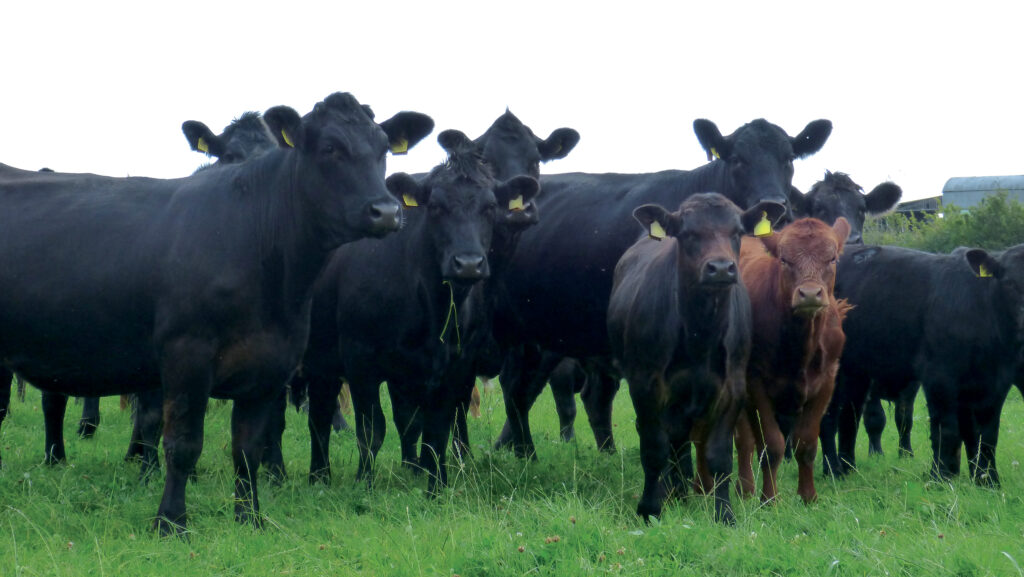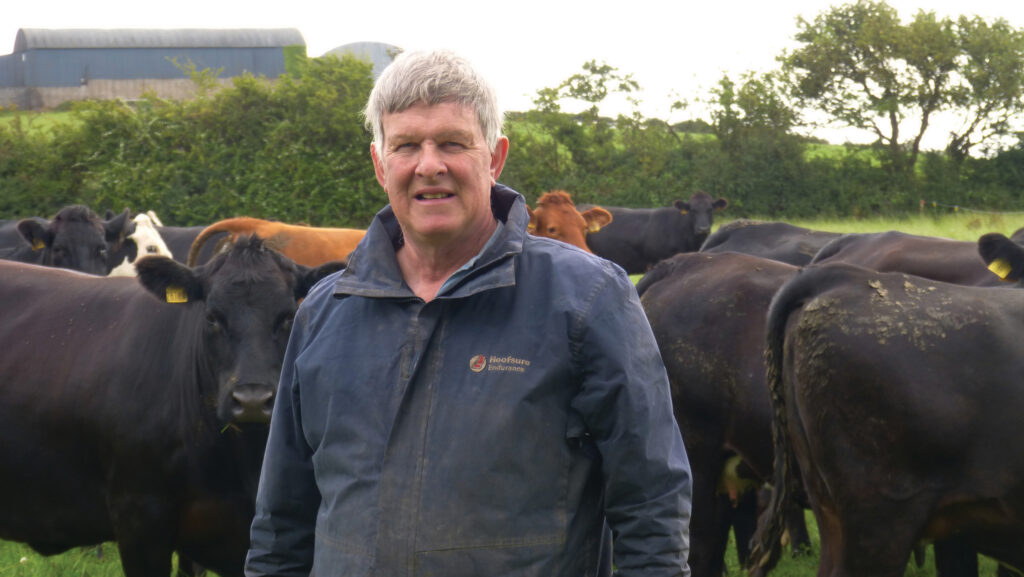How genetic switch grew margin £165 a cow on NI farm
 © MAG/Michael Priestley
© MAG/Michael Priestley A decision to breed functional, easy-fleshing livestock was taken just in time to spare a high-output grassland farm from the full pressures of monetary inflation.
Sam Chesney, who farms at Coolbrae Farm, Kircubbin, County Down, switched herd genetics for his spring-calving suckler cows to cut costs in 2020.
He admits there was an element of risk to this decision. Being a relatively small farmer, output and yield are important to make his enterprises stack up financially.
See also: Suckler business lifts margin £353/ha with fewer cows
However, farming very good land on the Ards Peninsula helped output: in 2022-23, the farm produced 1,489kg of liveweight/ha, of which 989kg was beef liveweight.
Farm Facts – Coolbrae Farm, Kircubbin, County Down
- 80ha farmed, of which 32ha is rented
- 120 crossbred suckler cows
- 100 commercial ewes
- Supplying ABP deadweight
- All grassland on heavy clay and clay loam soils
- Eight-week bulling period
- 25ha herbal leys
- 1ha paddocks on three-day moves
System change
Previously, the farm ran Limousin-cross and Blue-cross cows bred to high-index Limousin sires, averaging mature weights of 640kg.
In 2021, Sam opted for a Stabiliser to breed replacements, and he dropped continentals entirely last year.
The native bulls (Stabiliser, Hereford and Aberdeen Angus) he is now using are breeding thicker, deeper cows. They are slightly heavier (650kg), but are lower cost, says Sam.
Three years on and he is confident the change in genetics is working to his advantage (see “Cost savings and income change”), despite a noticeable drop in carcass weight.
“My old method of continental genetics and lots of bought-in feed worked fine. But times change,” he explains.
The bull team now comprises three Stabilisers from Billy O’Kane, Ballymena. Heifers are bred by artificial insemination to Angus, using straws from Netherton and Rawburn sires and top 1% Stabilisers, followed by a Solpoll Hereford bull.
Genetic impact
Cows are still housed for four to five months on slats before calving from mid-March on straw.
All housed cattle are fed through a tub mixer from a silage clamp. Even so, the bought-in feed bill over the past four financial years has fallen from £60,000 to £38,000.
“That drop is on the cattle,” explains Sam. “I only buy 1t of ewe nuts a year for the sheep and finish the lambs entirely off grass.”
Cost savings and income change
Vet and medicine
- Previous cost About £7,000 was spent annually, with vet call-outs for three or four caesareans and several prolapses. Costs in March and April could easily amount to £2,000/month.
- Current cost £3,500/year. Costs in March and April this year were £7 and £125, respectively.
- Comments The budget includes a synchronisation programme to breed heifers to high-index Angus semen. The main items are pneumonia vaccines. There is less dehorning work and antibiotics use.
- Saving £29.16 a cow
Bull creep feed
- Previous cost £4,080 for about 12t of creep fed ad-lib to bulls from June to help the weaning process.
- Current cost £2,040 for 6t at £340/t. The rate of creep has halved to 6t, which is fed later and in smaller amounts.
- Comments Sam thinks the creep feeder will pull out nose flaps, so tries to minimise using it. However, the young bulls achieve a feed conversion rate of 4:1, which he says justifies the expense and hassle of creep feeding.
- Saving £17 a cow
Bull finisher blend
- Previous cost Costs for bull finishing rations vary each year according to silage quality and additional blend required. The 2023-born native-cross bulls showed the natives were doing 1.6kg/day at grass, while the continental bulls achieved 1.2kg/day. This performance gulf continued in the finishing shed, so Sam’s nutritionist advised feeding an additional 2kg/day of finisher blend to the continentals.
- Current cost The full saving should be seen next summer when all bulls are by native sires.
- Comments The native crosses had all reached slaughter weight at 13-15 months of age by the time the continentals caught up in July. A further 6kg of blend is saved on the native-bred heifers over a 120-day finishing period.
- Saving £93.60 a cow (based on 52p a head a day at £260/t (2024 price) for 180 days for bull finisher blend).
Forage
- Previous cost £540 a cow and calf unit, working on industry standard figures of 12t silage at £45/t.
- Current cost £432 a cow and calf unit. Sam believes improved feed efficiency of cows and calves has led to a fall in forage requirements by at least 20%.
- Comments The farm had more than 700t of silage carried over this winter, which Sam puts down to using easy fleshing native genetics and feed efficiency attributes done by the Stabiliser Cattle Company.
- Saving £108 a cow.
Total saving £247.76 a cow. (Note, this figure is based on 120 cows having bull calves in 2024 and actual prices paid by the farm. Greater blend savings are seen in heifers).
Calves reared
- This summer, the herd is on course to wean 98% after turning out 101%. Having eight more calves at the end of the year at a conservative value of £850 is worth £6,800, or £56.66 a cow.
Carcass weight
- Continental bulls grossed £1,821 for a 385kg U-grade carcass (at June price of £4.73/kg); natives bulls grossed £1,682 for a 365kg R-grade carcass (£4.61/kg).
- Continental carcasses were worth £139 more.
Net benefit
£165 a cow
Mental health
A further benefit from changing the farm’s bull genetics is the often-overlooked impact on mental health and stress of coping with calf mortality.
“Losing calves is terrible. It’s part of farming, but it’s still very demoralising having to pick up dead calves,” he says.
He recalls his old system, where he had to pull dozens of calves every spring, whereas this year he assisted just two backwards-presenting calves out of 120 calvings.
This is important as Sam farms largely on his own, although is helped occasionally by daughter Lauren and son Robert, who live in the area.
“I’m at the age where docile cattle that are less work are really important,” he adds.

Sam Chesney © MAG/Michael Priestley
The numbers: Bull finishing diet
16.4
Amount of feed (kg dry matter (DM)) all the bulls were rationed to eat
4
Amount of red clover silage (kg DM)
6
Amount of grass silage (kg DM)
6
Amount of finisher blend (kg) fed to the native-bred cattle, along with 0.4kg straw (the continentals got 2kg more)
Future plans
Sam will continue to try to whittle away at his feed bill. Another saving has been made by producing stemmy silage to replace straw, which Sam says has become too dear to feed.
“It was so wet last summer we took second cut on 23 August, but it was ideal for wintering cows.”
Coolbrae is currently stocked at 2.3 livestock units (LSUs)/ha, although Sam is planning on increasing sheep numbers.
This is because ewes are only housed to lamb at night, and are outwintered on grass, so it would reduce the number of LSUs being housed over the winter.
